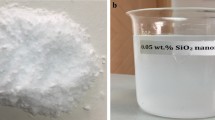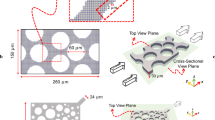Abstract
The stability of the waterfront in a heterogeneous porous medium and in the absence of gravity effects is controlled by capillary and viscous forces. Under oil-wet conditions, waterflood is a drainage process and the displacement front advances in zones with larger pores where capillary forces are lower, and the rate of displacement is higher compared to zones with smaller pores. Hence, in a waterflood process, a transition zone is formed where the water saturation gradually decreases from a trailing front to the leading end of advanced water fingers. In a heterogeneous medium, oil–water capillary pressure fluctuates due to variations of pore sizes in flooding paths. The difference in the capillary pressures between leading and trailing zones can help with the stability of the waterfront when the capillary pressure in frontal zones is increased by displacing oil through smaller pores. However, this mechanism creates a limited pressure gradient in the oil phase, so the waterfront instabilities continue to grow, especially at the adverse mobility ratio and high displacement rates. In this study, different oil samples with low, medium and high viscosities are displaced by water in an oil-wet medium containing pore-level heterogeneities. Herein, the effect of flow swing, which is introduced to the direction of oil–water displacement, on waterflood performance is investigated. Under flow-swing conditions, we reverse the fluid flow direction periodically; however, the overall volume of injected water is maintained the same for all scenarios by adjusting the periods of the forward and reverse steps. The flow reversal promotes the refill of water paths with oil, hence attenuating the advanced fingers. Consequently, the sweep efficiency of waterflood is improved and higher oil sweep efficiency is obtained at the time of breakthrough. The flow-swing mechanism is more effective when oscillations of capillary pressure result in a faster flow of oil between trailing and leading zones, thus decreasing the waterfront instabilities. The new process can be optimized and utilized at larger scales for improving the sweep efficiency of flooding operations.



















Similar content being viewed by others
References
Abrams, A.: The influence of fluid viscosity, interfacial tension, and flow velocity on residual oil saturation left by waterflood. Soc. Pet. Eng. J. 15(05), 437–447 (1975)
An, S., Yao, J., Yang, Y., Zhang, W., Zhao, J., Li, A.: The microscale analysis of reverse displacement based on digital core. J. Nat. Gas Sci. Eng. 48, 138–144 (2017)
Armstrong, R.T., Berg, S.: Interfacial velocities and capillary pressure gradients during Haines jumps. Phys. Rev. E 88(4), 043010 (2013)
Atamanchuk, I.: Pressure Pulsing Potential During Waterflooding and CO2 Flooding of Heavy Oil Reservoirs. Faculty of Graduate Studies and Research, University of Regina, Regina (2014)
Avaginina, D., Segura, R., Muniategui, M., Sanchez-Lona, A., Keshka, A., Kolli, K., & Wegman-Sanchez, J.: An Innovative Waterflood Optimization Method for Unconsolidated Sandstone Reservoirs to Increase Production, Lower Water-Cut, and Improve or Stabilize Base Oil Decline Rate. In: Paper presented at the Pan-American Mature Fields Congress, Bueons Aires, Argentina (2013)
Bazazi, P., Sanati Nezhad, A., Hejazi, S.H.: Wetting phase disintegration and detachment: three-dimensional confocal imaging of two-phase distributions. Phys. Rev. Appl. 11(10), 014042 (2019)
Berg, S., Armstrong, R., Georgiadis, A., Ott, H., Schwing, A., Neiteler, R., Leu, L.: Onset of oil mobilization and nonwetting-phase cluster-size distribution. Petrophysics 56(01), 15–22 (2015)
Chatzis, I., Morrow, N.R., Lim, H.T.: Magnitude and detailed structure of residual oil saturation. Soc. Pet. Eng. J. 23(02), 311–326 (1983)
Craig, F.F.: The reservoir engineering aspects of waterflooding, vol. 3. HL Doherty Memorial Fund of AIME AIME, New York (1971)
Davidson, B., Dusseault, M., Wang, J.: Laboratory experiments on pressure pulse flow enhancement in porous media. Paper presented at the Technical Meeting/Petroleum Conference of The South Saskatchewan Section. (1999)
Dias, M.M., Payatakes, A.C.: Network models for two-phase flow in porous media Part 1. Immiscible microdisplacement of non-wetting fluids. J. Fluid Mech. 164, 305–336 (1986)
Dong, M., Zhou, J.: Characterization of waterflood saturation profile histories by the ‘complete’capillary number. Transp. Porous Media 31(2), 213–237 (1998)
Dullien, F.A.: Porous Media: Fluid Transport and Pore Structure. Academic Press, Cambridge (2012)
Dusseault, M., Davidson, B., Spanos, T.: Pressure pulsing: the ups and downs of starting a new technology. J. Can. Pet. Technol. 39(4), 13–17 (2000a)
Dusseault, M.B., Davidson, B.C., Spanos, T.J.: Removing mechanical skin in heavy oil wells. In: Paper Presented at the SPE International Symposium on Formation Damage Control. (2000b)
Dusseault, M.B., Shand, D., Meling, T., Spanos, T., Davidson, B.C.: Field applications of pressure pulsing in porous media. In: Paper Presented at the Proceedings of the 2nd Biotechnology Conference on Poromechanics, Grenoble, France, Balkema, Rotterdam. (2002)
Escobar-Remolina, J., Barrios-Ortiz, W., Mantilla-Villamizar, J., Vargas-Medina, J., Sanabria-Gomez, L., Wegman, J., Sanchez Lona, A.: An Effective Accelerated Pulsing Injection Method for Restoring Injectivity in Waterflood Fields with Selective Injection Systems with Side-Pocket Mandrels and Control Flow Valves. In: Paper presented at the SPE Western North American and Rocky Mountain Joint Meeting. (2014)
Garstecki, P., Fuerstman, M.J., Stone, H.A., Whitesides, G.M.: Formation of droplets and bubbles in a microfluidic T-junction—scaling and mechanism of break-up. Lab Chip 6(3), 437–446 (2006)
Green, D.W., Willhite, G.P.: Enhanced Oil Recovery, vol. 6. Henry L. Doherty Memorial Fund of AIME, New York (1998)
Hickok, C., Christensen, R., Ramsay, H., Jr.: Progress review of the K&S carbonated waterflood project. J. Petr. Technol. 12(12), 20–24 (1960)
Idowu, N.A., Blunt, M.J.: Pore-scale modelling of rate effects in waterflooding. Transp. Porous Media 83(1), 151–169 (2010)
Jadhunandan, P., Morrow, N.R.: Effect of wettability on waterflood recovery for crude-oil/brine/rock systems. SPE Reserv. Eng. 10(01), 40–46 (1995)
Jerauld, G., Salter, S.: The effect of pore-structure on hysteresis in relative permeability and capillary pressure: pore-level modeling. Transp. Porous Media 5(2), 103–151 (1990)
Jeroen, G., Sau-Wai, W., Tor, M., Robert, Z., Brett, D.: Pulsed Water Injection During Waterflooding. In: Paper Presented at the SPE International Improved Oil Recovery Conference in Asia Pacific. (2003)
Khorshidian, H., James, L.A., Butt, S.D.: Demonstrating the effect of hydraulic continuity of the wetting phase on the performance of pore network micromodels during gas assisted gravity drainage. J. Pet. Sci. Eng. 165, 375–387 (2018)
Lenormand, R., Touboul, E., Zarcone, C.: Numerical models and experiments on immiscible displacements in porous media. J. Fluid Mech. 189, 165–187 (1988)
Maaref, S., Ayatollahi, S., Rezaei, N., Masihi, M.: The effect of dispersed phase salinity on water-in-oil emulsion flow performance: a micromodel study. Ind. Eng. Chem. Res. 56(15), 4549–4561 (2017)
Mai, A., Kantzas, A.: Mechanisms of Heavy Oil Recovery by Low Rate Waterflooding. In: Paper presented at the Canadian International Petroleum Conference. (2008)
Mogensen, K., Stenby, E.H.: A dynamic two-phase pore-scale model of imbibition. Transp. Porous Media 32(3), 299–327 (1998)
Moore, T.F., Slobod, R.L.: The effect of viscosity and capillarity on the displacement of oil by water. Prod. Mon. 20(10), 20–30 (1956)
Morrow, N., Buckley, J.: Improved oil recovery by low-salinity waterflooding. J. Pet. Technol. 63(05), 106–112 (2011)
Morrow, N.R.: Wettability and its effect on oil recovery. J. Pet. Technol. 42(12), 1–476 (1990)
Needham, R.B., Doe, P.H.: Polymer flooding review. J. Pet. Technol. 39(12), 1–503 (1987)
Olajire, A.A.: Review of ASP EOR (alkaline surfactant polymer enhanced oil recovery) technology in the petroleum industry: prospects and challenges. Energy 77, 963–982 (2014)
Peng, B., Zhang, L., Luo, J., Wang, P., Ding, B., Zeng, M., Cheng, Z.: A review of nanomaterials for nanofluid enhanced oil recovery. RSC Adv. 7(51), 32246–32254 (2017)
Reed, R.L., Healy, R.N.: Some physicochemical aspects of microemulsion flooding: a review. Papers presented at the 1976 AIChE Symposium on Improved Oil Recovery by Surfactant and Polymer Flooding held in Kansas City (1977)
Riazi, M., Sohrabi, M., Jamiolahmady, M.: Experimental study of pore-scale mechanisms of carbonated water injection. Transp. Porous Media 86(1), 73–86 (2011)
Rücker, M., Berg, S., Armstrong, R., Georgiadis, A., Ott, H., Schwing, A., Leu, L.: From connected pathway flow to ganglion dynamics. Geophys. Res. Lett. 42(10), 3888–3894 (2015)
Schlüter, S., Berg, S., Rücker, M., Armstrong, R., Vogel, H.J., Hilfer, R., Wildenschild, D.: Pore-scale displacement mechanisms as a source of hysteresis for two-phase flow in porous media. Water Resour. Res. 52(3), 2194–2205 (2016)
Shchipanov, A., Surguchev, L., Jakobsen, S.: Improved oil recovery by cyclic injection and production. Paper presented at the SPE Russian Oil and Gas Technical Conference and Exhibition. (2008)
Smith, J.T., Cobb, W.M.: Waterflooding. Midwest Office of the Petroleum Technology Transfer Council, Champaign (1997)
Spanos, T., Davidson, B., Dusseault, M., Shand, D., Samaroo, M.: Pressure pulsing at the reservoir scale: a new IOR approach. J. Can. Pet. Technol. 42(2), 16–28 (2003)
Spanos, T.J.: The Thermophysics of Porous Media. Chapman and Hall/CRC, Boca Raton (2001)
Wang, J., Dusseault, M.B., Davidson, B., Spanos, T. Fluid enhancement under liquid pressure pulsing at low frequency. In: Paper Presented at the Proceedings of 7th Unitar International Conference on Heavy Crude and Tar Sands, Bei**g, PRC. (1998)
Yao, C., Lei, G., Hou, J., Xu, X., Wang, D., Steenhuis, T.S.: Enhanced oil recovery using micron-size polyacrylamide elastic microspheres: underlying mechanisms and displacement experiments. Ind. Eng. Chem. Res. 54(43), 10925–10934 (2015)
Acknowledgements
The authors acknowledge research support from Canadian Foundation for Innovation, the University of Calgary Global Research Initiative in Unconventional Hydrocarbon Resources-Bei**g Site, Kerui-MITACS Accelerate Research Fund Application Ref. IT09328, and National Science Foundation of China (grant no. 51950410591).
Author information
Authors and Affiliations
Corresponding author
Additional information
Publisher's Note
Springer Nature remains neutral with regard to jurisdictional claims in published maps and institutional affiliations.
Supplementary information
Below is the link to the supplementary information.
Rights and permissions
About this article
Cite this article
Khorshidian, H., Afshari, S., Bagherzadeh, H. et al. The Effect of Flow Swing on Waterflood Under Oil-Wet Conditions: A Pore-Level Study. Transp Porous Med 137, 109–130 (2021). https://doi.org/10.1007/s11242-021-01549-7
Received:
Accepted:
Published:
Issue Date:
DOI: https://doi.org/10.1007/s11242-021-01549-7




